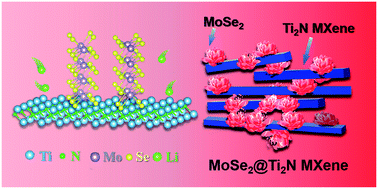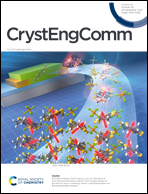Interfacial superassembly of MoSe2@Ti2N MXene hybrids enabling promising lithium-ion storage†
Abstract
In this work, we present an interfacial superassembly by engineering MoSe2 nanoflowers coupled with ribbon-like Ti2N MXene frameworks (MoSe2@Ti2N MXene). The MoSe2@Ti2N MXene hybrids have excellent electrochemical performance and are used as anode materials for lithium-ion batteries (LIBs). Etching the Ti2AlN precursor under different conditions results in two kinds of novel materials with different morphologies: sliced etched-Ti2N and ribbon-like Ti2N MXene. Electrochemical analysis indicates that the ribbon-like Ti2N MXene frameworks not only help to avoid side reactions on carbides in LIBs, but also contribute to the outstanding rate capacity and superior specific capacity, thus achieving ultra-stable long-life cycling performance. The distinctive flower-like MoSe2 can be assembled onto the ribbon-like Ti2N MXene substrate by the interfacial superassembly. The MoSe2@Ti2N MXene electrode reveals a reversible specific capacity of 826 mAh g−1 at a current density of 0.1 A g−1 after 200 cycles. It maintains a capacity of 489 mAh g−1 after 2000 cycles at 1.0 A g−1 indicating satisfactory cycling stability. The new-type interfacial superassembly can provide a novel synthesis strategy for anode electrodes to improve the performance of LIBs.



 Please wait while we load your content...
Please wait while we load your content...